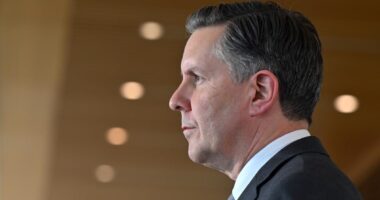BIDDEFORD — Last year, University of New England College of Osteopathic Medicine students practiced responding to a mock mass casualty incident just a week before the mass shooting in Lewiston that took the lives of 18 people and left 13 wounded. On Saturday, approaching the one-year anniversary of the tragedy, the training was back with a renewed significance and a focus on the lessons learned on and after Oct. 25, 2023. They also heard from the chief of surgery at Central Maine Healthcare in Lewiston, who coordinated the immediate response when the shootings occurred. The fourth annual student-run mock mass casualty session was hosted by the school’s World Association for Disaster and Emergency Medicine chapter. About 60 students attended, including those in medical, physical and occupational therapy, dental and other disciplines, and 20 others who volunteered to act in the mock emergency training. “We decided it was relevant and appropriate for us to include (the Lewiston mass shooting) in our trainings, because this is what health care providers will be dealing with throughout their careers, for all professions, whether that’s nursing, college of osteopathic medicine, dental, PT, OT, it’s unfortunately relevant in our present day,” said Wyatt Blackstone, a second-year medical student and president of the disaster and emergency medicine chapter. The morning of the training featured talks from physicians, including Dr. Sean Bilodeau, a UNE medical school graduate and current EMS fellow at Maine Medical Center in Portland, and Dr. Timothy Counihan, Central Maine Healthcare’s chief of surgery. Counihan coordinated the immediate response to the Lewiston shooting and saw more than a dozen people come through the Central Maine Medical Center emergency room with gunshot wounds. Counihan spoke about how emergency care providers decide to allocate resources during mass casualty incidents – incidents in which there are more people injured than resources available. In the Lewiston shootings, Counihan said, his medical team had to decide which victims to operate on first based on who had the greater chance of survival. “This is an enormous burden on our hospital,” Counihan said, adding that staffing, blood bank supplies and other resources were put to the test during the Lewiston tragedy. On top of performing more than 60 procedures on gunshot victims, physicians faced the added challenge of having to keep the hospital operating as usual for routine procedures, and do it all after dealing with the stress of a two-day lockdown and the manhunt for gunman Robert Card, Counihan said. Going forward, Counihan said, hospitals and first responders must prepare for mass casualty scenarios by practicing triage procedures, holding “stop the bleed” trainings and stocking supplies like gauze and tourniquets in emergency departments. “No amount of planning is going to prepare you for it, because each mass shooting is actually a little different,” Counihan said. Mass casualty incidents like the one in Lewiston also leave a lasting impact on the mental well-being of the community, Counihan said, which is why it was important that CMMC had counselors available for victims and staff in the immediate aftermath of the shooting. “We had mental health counseling in the ICU on computer screens, like day one,” Counihan said. “The patients, they started counseling while they were still in the ICU, as soon as they were asking. So that’s something I hadn’t seen before, which was impressive. And then also, we set up a counseling system for the employees.” Following Counihan’s lecture, LifeFlight of Maine landed on the campus athletic fields and students had an opportunity to learn from the first responders on board. Then, students moved to “skills stations” to learn about some of the procedures done during mass casualty scenarios, including burn and wound care and intubation. The day ended with two mock scenarios led by student teaching assistants and debriefs with physicians. One of the TAs, second-year medical student Alicia Muench, said that preparing for mass casualty situations like shootings and car crashes helps medical professionals when the worst-case scenario becomes reality. “Even just having a little bit of background knowledge, I think, really reduces that anxiety in the situation,” Muench said. “You kind of go back to what you know, and say, ‘OK, I remember doing this during the training, let me try and do that.’ So it gives you a little bit of familiarity.” Student leaders planned Saturday’s events around the interprofessional services patients receive in real-world mass casualty events, beyond the immediate triage and emergency room care. “When patients are out in the real world, they’re not going to be dealing with one provider, they’re going to be dealing with a wide array of providers, from occupational therapy … PT, doctors, nurses, the whole wide array,” Blackstone said. “So in order to provide better care and training for providers in the future, we want to expose people to as many different professions as possible, because we’re all going to be working together in a real-life event.”
Subscribe
Login
0 Comments




